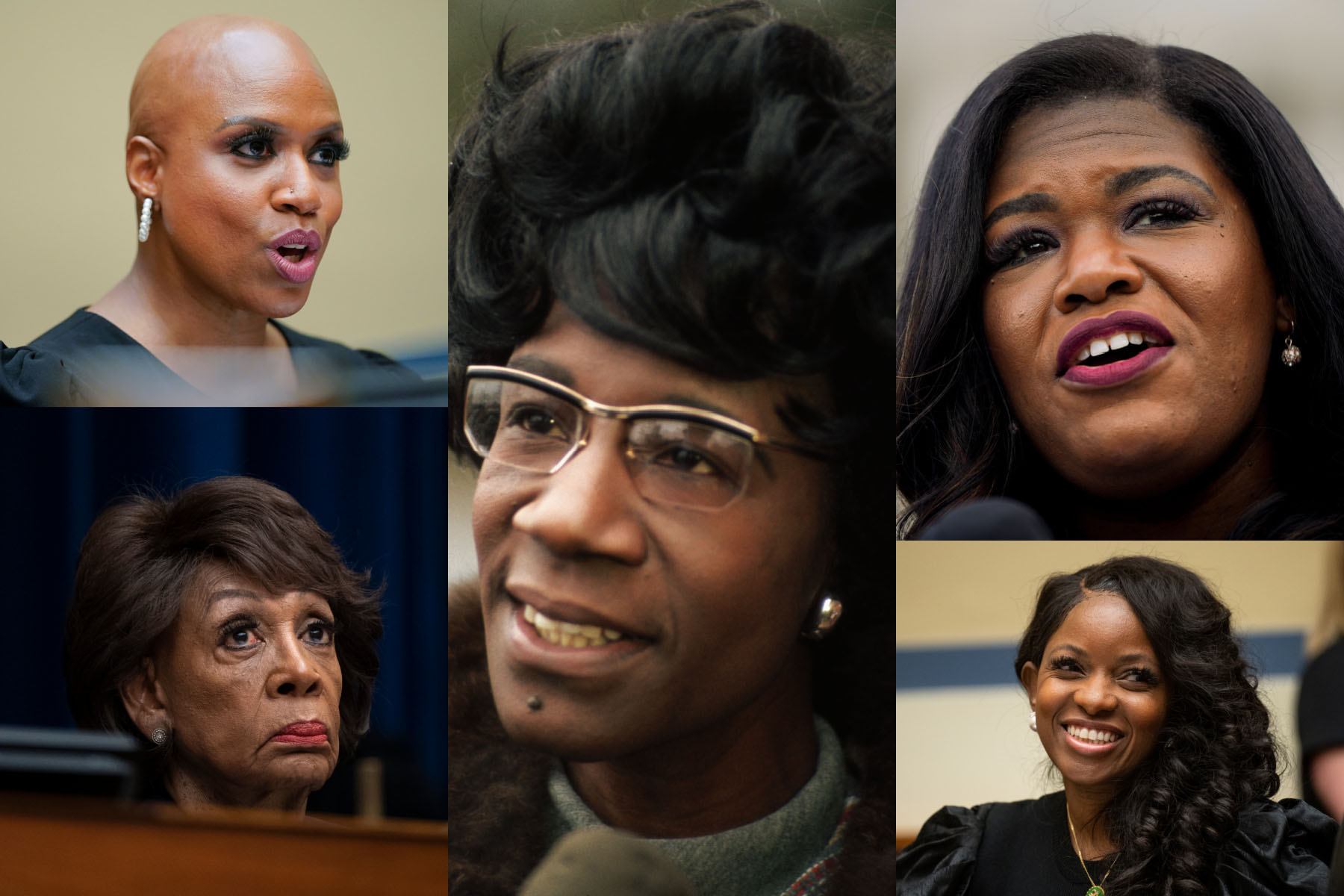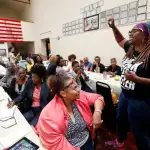This column first appeared in The Amendment, a new biweekly newsletter by Errin Haines, The 19th’s editor-at-large. Subscribe today to get early access to future analysis.
The 2018 midterms were known as “The Year of the Black Woman,” as a record-setting five of them were elected to Congress.
It was also the year I met Glynda Carr. Seven years earlier, she and Kimberly Peeler-Allen started Higher Heights for America, proclaiming their mission as “a national movement to grow Black women’s political power from the voting booth to elected office.”
The first step was to define the problem. Back then, it was clear to Carr that underrepresentation for Black women was an issue, but no one was quantifying it specifically. Instead, there were reports focused on women more broadly, or even women of color.
In 2014, Higher Heights and the Center for American Women and Politics (CAWP) published the first Black Women in American Politics report. The report’s seventh edition first published in my Wednesday newsletter.
It outlines the record number of Black women running for and winning seats in Congress, state legislatures and mayoral offices, as well as the progress and challenges for Black women running for statewide and federal office. While the report points out that there are still no Black women governors or any currently serving in the U.S. Senate, it also talks about the lessons learned in defeat as Black women organizers, voters and candidates look to the future.
Carr credits the boldness of many of today’s Black women candidates and elected officials stepping forward to lead. And she acknowledges the contributions of groups like hers, and the Black women leading advocacy organizations that are also focused on electing candidates and mobilizing their members into voters like Emily’s List, the Human Rights Campaign and the National Domestic Workers Alliance, as sharing in these victories.
“We’ve been spending a lot of time talking about Black women’s political leadership,” Carr told me. “To be in this moment for Black women to vote, run, win and lead … from the local Black women organizers informally to the rise of Black women organizers and leaders on the local and national level, pushing for narrative change and pushing for investment that has actually led to this moment.”
In 1968, Shirley Chisholm became the first Black woman elected to Congress. Today, a record 28 Black women are serving as voting members, plus two non-voting delegates, all of them Democrats. Black women make up 5.2 percent of all members of Congress, 45.9 percent of Black members of Congress and 22.4 percent of all women.
The report points out that some of the newer Black women in Congress, including Summer Lee of Pennsylvania and Jasmine Crockett of Texas, are entering office at a younger age than their predecessors. Among all Black women who have entered Congress since 2018, the average age is 46, compared with 52 for all Black women who entered prior to 2018. (Chisholm was elected at 43.)
It’s proof that Black women need not spend decades in places like state legislatures, which are often a path to higher office, before pursuing congressional seats. And the earlier they get there, the better chance these Black women have to build up seniority and enter leadership roles.
Prior experience is a huge part of the path. Of the Black women serving in Congress, 75 percent served in state legislative and/or local elective offices. All five of the Black women elected for the first time in 2022 came from their state legislatures. It’s not that women who lack previous elected office experience shouldn’t run or can’t win, but it’s an advantage that often brings with it experience, name recognition and networks of supporters.
“Black women are taking chances when there’s an opportunity,” Carr said. “There’s an acceleration of the pipeline.”
Carr predicts even more of an acceleration over the next decade at the congressional level as more seats become open for reasons varying from retirement to redistricting. As Black women continue to build the bench, she said, they’ll be primed to step into those races, run competitively and win.
Chisholm was the lone Black woman in Congress for five years. Today, her legacy is the Black women trailblazers serving alongside the Black women who are rising in our politics — including Massachusetts’ Ayanna Pressley, who inherited Chisholm’s old office.
In all, 55 Black women from 23 states have served in Congress, including two Black women senators. Chisholm famously said, “If they don’t give you a seat at the table, bring a folding chair.”
As Black women have increasingly claimed their seats at the table, what does this mean for questions of electability and power? In the spirit of Chisholm, said Kelly Dittmar, director of research at CAWP, these women are stepping forward not only as a matter of representation, but as a means to building power.
“They are willing to put themselves out there and set a precedent that Chisholm and women like her belong in these spaces,” Dittmar said. “That has certainly continued to this day with increased diversity among these women. There are newer classes of Black women in Congress who are rejecting business as usual and not waiting on the party endorsement.”
Black women including Reps. Lauren Underwood in Illinois or Jahana Hayes in Connecticut, both part of the class of 2018, are also running and winning in districts that are not majority-minority. It’s a change from the dynamic that helped usher in the first Black members of Congress after the passage of the Voting Rights Act of 1965, and a sign that other paths to victory are opening up. This can help expand the political imagination of where Black women can and should be able to lead, rejecting the electability biases of the past.
Their appeal, in part, is in their authentic “we not me” pitch to voters that is not unique to Black women, but that often comes through in these candidates in ways that resonate even with voters who may not share their racial or gender identities.
In an era of toxic politics, when people have low esteem for elected leaders, this approach may be attractive, Dittmar said. “When you’re in it for community, you’re willing to lose power and you’re not going to back down.”
The Black women who have long been the backbone of our democracy are increasingly becoming part of the brain trust at all levels of government. This has happened after decades of demanding more representation and a return on their investment at the ballot box, mainly from the Democratic Party.
The CAWP/Higher Heights report notes a record eight Black women serving as mayors of the largest 100 cities. Ten Black women are serving in statewide elective executive offices, as attorneys general, controller, lieutenant governor, secretaries of state and auditor.
As of May, a record 372 Black women are serving as state legislators, making up 5 percent of all state lawmakers and 15.4 percent of all women in statehouses. And Black women also hold a record 15 state legislative leader posts, including six who lead their legislative chambers.
Black women are 7.7 percent of the U.S. population. In two states — Alabama and Georgia, both with Black women making up 25 percent of women in those states — Black women are more than 50 percent of the state’s women legislators, but are all serving in the minority party. Nearly half of all state legislatures fall short of equal representation of Black women, and Mississippi, Louisiana and South Carolina — all with Republican majorities — have among the biggest disparities.
The paths to victory have been less clear and more daunting at and near the top. Both of the two most powerful Black women in American politics — Vice President Kamala Harris and Supreme Court Justice Ketanji Brown Jackson — were nominated by President Joe Biden. Harris was elected alongside Biden in 2020 and Jackson was confirmed by the Senate last April and sworn in a year ago this week.
In some ways, the takeaway from this report could be that the more things change, the more they stay the same.
Black women continue to run for and win elected office in record numbers, but our representation at some of the highest offices remains elusive, and our increased numbers aren’t always translating into power or policy at the state or federal level. As a new election cycle gets underway, there are new opportunities for Black women to break barriers and grow their ranks as members of Congress, mayors, statewide elected leaders and beyond.
But despite the gains in recent years, there are also persistent obstacles that have kept Black women out of the Senate and have failed to produce the first Black woman governor. And barring any surprises, 2024 won’t be the year a Black woman runs for president and potentially achieves another first for the race and gender.
I think and have written extensively about questions of Black women’s leadership as editor-at-large for The 19th. This latest version of Black Women in American Politics provides a fresh look at the state of play for a key electorate that has emerged as a force in shaping our politics and democracy and spotlights the problem of underrepresentation as a framework to outline the work ahead.
“Just simply having this data, to point it out, is the first step. Then there’s the work to mobilize voices to say to the powers that be that they need to be more intentional and directly supportive of Black women,” Dittmar said. “There is an active effort to ensure that those who are in these positions of power and influence are more thoughtful and responsive to the demands being rightfully made to see more representation.”
We’ll see what happens headed into 2024. Reports like this one will be part of my roadmap.








